#Oracle Forms Compile
Explore tagged Tumblr posts
Text


Okay, so we basically know very little/nothing, but I compiled everything I could find here :)
TW for religius themes [?]
Strap in
First of all, we know two definite Gods: the Allmother and Ocudeus.
The Allmother seems to be a benevolent deity that protects her believers. We can assume that since mr. Chocky was wishing upon her for mercy during the Soulless’ attack on the caravan and he was the only one not dying at that point (The Soulless kills him only after the MC’s curse has taken control of him).

Plus, the (Oracle! has the extra —[text]—) MC comments:
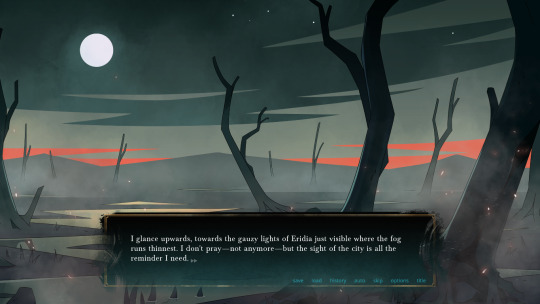
Is she the one who made the Soulless kill the traveller to save the MC? And cut their arms off to end their misery? Could she be protecting them?
Or did she not want her subject [the traveller] to suffer due to the MC's curse?
Was everything random and out of her control?
And that's basically everything we know about the Allmother.
Then we have Ocudeus. This ancient motherfucker— I had to rewind the damn game for this tentacle bitch again.
Anyway, we know he's the ancient, eldritch being Ais has formed a pact with" that gives him "borrowed, unnerving abilities."
Also, it is suspected that its name is likely from Latin oculus and deus ("eye" and "god") + that "Ocu" also means water in Betoi.
Now, onto the funny stuff: (Oracle!MC is the only one who comments on these)
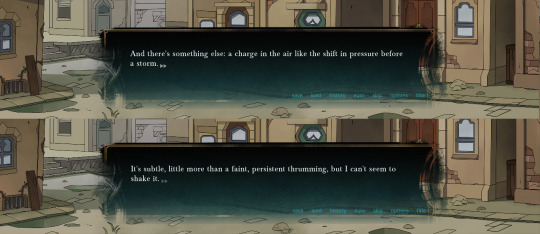
The MC can hear a heartbeat the moment they step out of Kuras' clinic
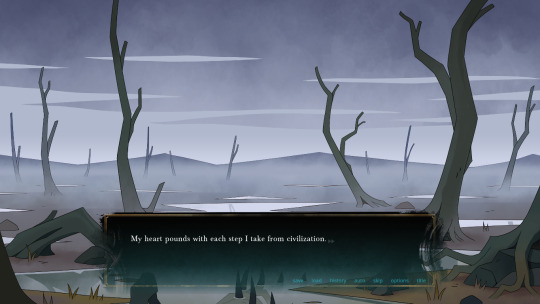

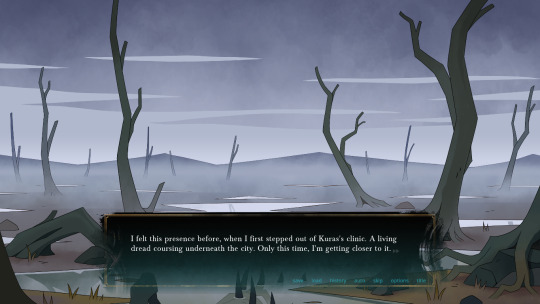
And it gets louder the closer they get to the Seaspring
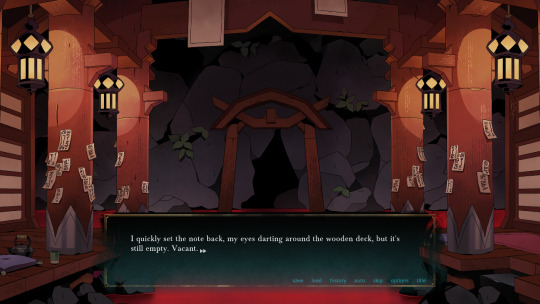
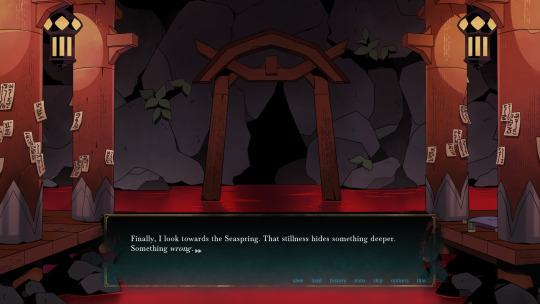
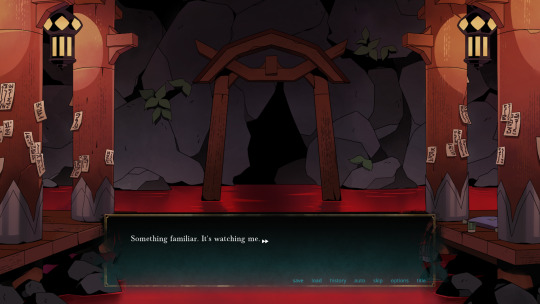
The MC can literally feel Ocudeus watching them from the Seaspring. What's interesting is that they find it familiar
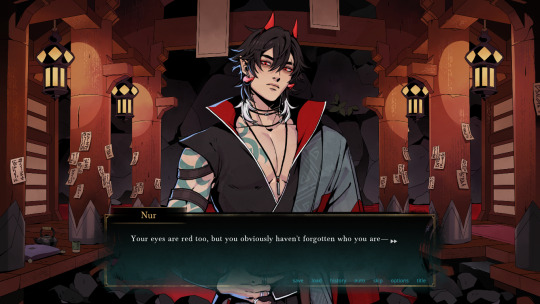

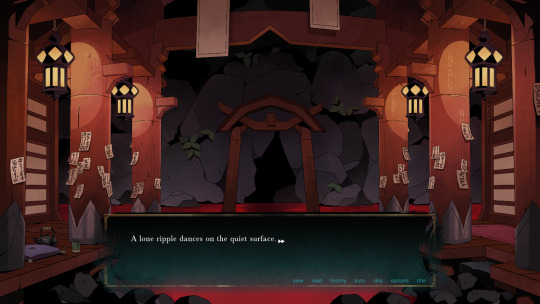

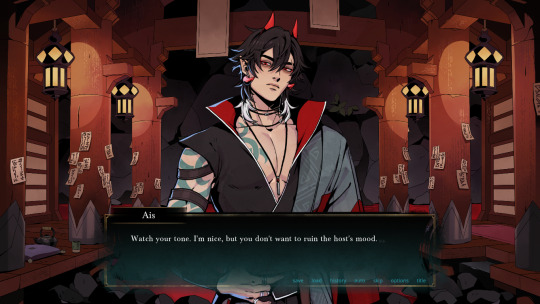
Ais warns the MC about "ruining the host's mood" [Could be interpreted as: "I'm (Ais) nice, but you don't want to ruin the host's (Ocudeus, who propably lives in the waters of the Seaspring) mood (by asking questions regarding its power and questioning its dominance/control over me)] — As if Ocudeus itself invited them over; that would explain how that lady knew the MC's name:


Either Ocudeus wanted to see them or it wanted to be fed tea leaves by Ais and felt it was nescessary to brought someone over for Ais to clean the damn temple once in a whie—
IN REGARDS TO AIS' RELATIONSHIP WITH OCUDEUS
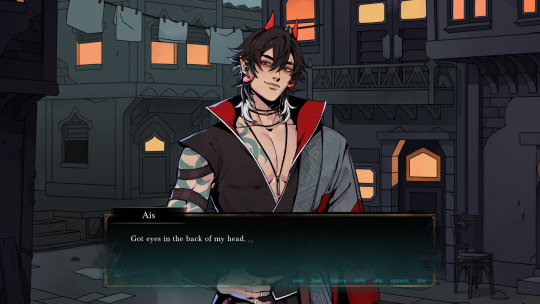
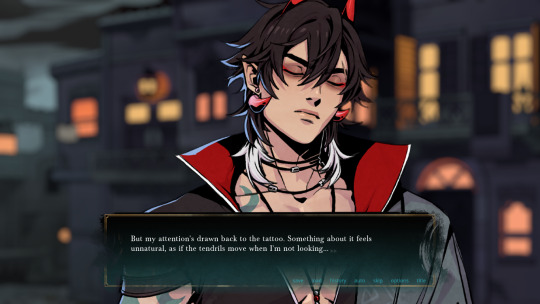
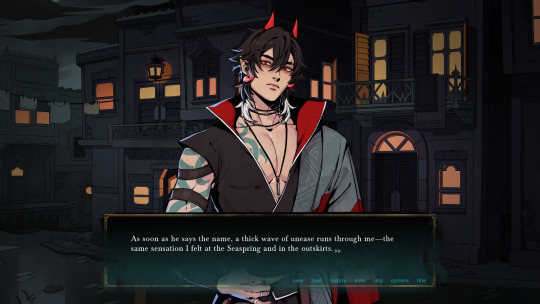

The MC's eyes always return to the mark, and only explanation left is that it was made by Ocudeus
WAIT. Pause and backtract to the Seaspring

Let's break them down:
1. The topmost
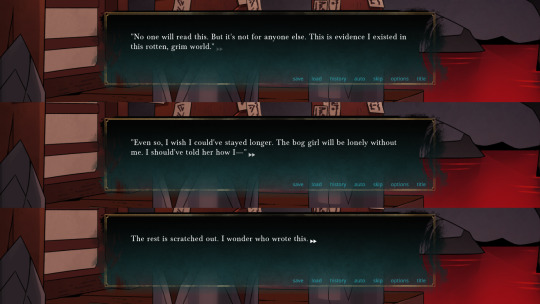
2. The closest one

3. The bottommost
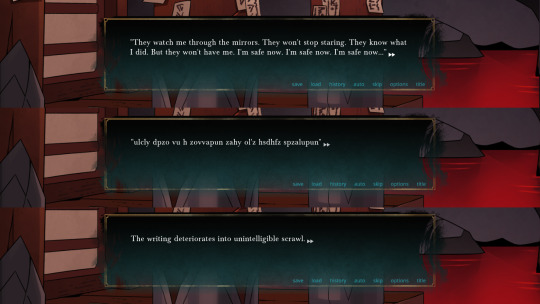
"ucly dpzo vu h zovvapun zahy ol'z hsdhfz spzalupun." - Both with Affine [A=1, B=7] and Mono-alphabetic Substitution (+10 other cyphers) it's the same message: NEVER WISH ON A SHOOTING STAR HE'S ALWAYS LISTENING
Since the notes are left there by people who have evidently drank from the Seaspring (“If you see me, never speak to me,” etc) I will take a wild guess and assume the bottomest note is Ais’ last moments before Ocudeus merged with him.
And also this ties with the whole “Ocudeus is a fallen god” (“shooting/fallen star”) who left the Shroud ignorant about the world beyond and ended up landing to Eridia
"A river bisects Eridia into two distinct halves: the flood-eroded districts of Lowtown, and the elevated, gilded city of Hightown." — Eridia's a river city and Ocudeus is a giant fucking octopus.
ᵂʰᵃᵗ ᶜᵒᵘˡᵈ ᵖᵒˢˢᶦᵇˡʸ ᵍᵒ ʷʳᵒⁿᵍˀ :⁾⁾
What I find interesting though is that if the note is truly by Ais, he mentions mirrors and eyes. He must have been trying to hide from something—Ocudeus or another deity?—that “knew what he did,” and let Ocudeus overtake him as a last resort, perhaps.
BUT WHAT'S THE DEAL WITH THE MIRRORS?!?!?!
THERE IS NOT ONE (1) MIRROR IN THE WHOLE DEMO. NOR IN THE PROMOS. NOT ONE. [unless I'm blind]
Sure, it could be the surface of the water and the whole thing is metaphoricall but it bugs me so muchhhhh

kuras Kuras KURAS KURAS KURAS KURAS
Recently, it was revealed that he, indeed, came out of the Shroud THOUSANDS OF YEARS BEFORE THE FOGFALL OCCURED
And I bring you a background issue:
"An angel is a heavenly supernatural or spiritual being. In monotheistic belief-systems, such beings are under service of the supreme deity (i.e. God)."
Is he autonomous or does he worship a god? And if so, WHICH GOD?!
Perhaps, and take that with a grain of salt, perhaps Allmother
[Does anyone see a pattern? 'Cause I do]
What if Kuras' greatest sin was leaving the Shroud?
Kuras came through the Shroud because he loved humanity. He's had human friends, colleagues, and lovers...
Their incorporeal spirits take physical form, strengthening some and weakening others. The longer they spend in the human world, the better they adapt.
Kuras loved humanity so much he up and left the Shroud and gifted humans all the knowledge he possessed. He risked his power - perhaps his life - as he travelled through.
And so I ask you; Is that his biggest regret? Him loving humans to the extend of abandoning the Shroud and his creator for a life of teaching them, only for his efforts to result in "trinkets, pleasure, and petty tyranny"?
And lastly, Vere
I want you to keep an open mind with this
We know from his character lore that
"Centuries ago, the Senobium bound a wicked beast with a magic collar, sealing his powers and forcing his obedience."
and we know Vere has lived for over a century
BUT THE THING IS: ancient ≠ century [also mentioned here]
WHAT IF
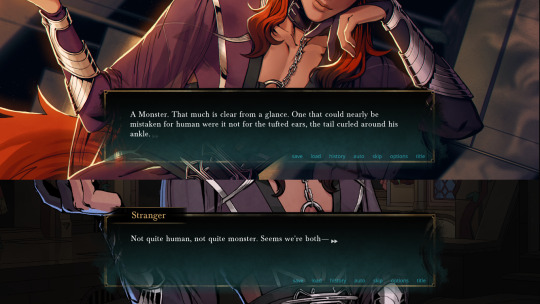
"Seems we're both cursed"
What if Vere used to be human and attempted to take the ancient beast's power [remember, his fatal flaw: "Lusts for power, no matter the consequences"]
He obviously succeeded and became what he is now, while simultaniously getting chained for one reason or another;
The Senobium obviously sees him as a threat but uses him for his abilities anyways
Prehaps he couldn't control the power he gained?
He could have been a theif wanting a better life, like the Hound!MC
He could have been affiliated with the Senobium in another way before
But we know one thing for sure:

He, too, was betrayed and caused havoc unintentionally
Perhaps in regard to the beast's powers?

#vereletters#touchstarved theory#touchstarved theories#ts theory#ts theories#touchstarved vere theory#ais#ais ts#ts ais#ais touchstarved#touchstarved ais#vere#vere ts#ts vere#vere touchstarved#touchstarved vere#touchstarved ais theory#touchstarved kuras theory#kuras#kuras ts#ts kuras#kuras touchstarved#touchstarved kuras#redsringstudio#red spring studios
131 notes
·
View notes
Text
(っ◔◡◔)っ ♥ What is tarot? ♥
Hey guys so sorry for not updating I kinda was going through some things and now that school break has started and I'm a few days in I'll be compiling a bunch of posts on my two accounts to then schedule out so that they can be uploaded in a timely manner
Anyways hope you guys find this helpful!!
Tarot is one of the most well-known forms of divination, or the practice of seeking insight through spiritual or intuitive means. It uses a deck of structured cards to explore questions, situations, emotions, and potential paths.
Let’s break it down:
🃏Tarot Basics🃏
A traditional tarot deck has 78 cards:
22 Major Arcana cards, which reflect big themes, lessons, and turning points
56 Minor Arcana cards, which deal with everyday events, thoughts, feelings, and challenges
Minor Arcana are split into 4 suits (like playing cards):
Wands – Passion, creativity, energy
Cups – Emotions, relationships, intuition
Swords – Thoughts, conflict, communication
Pentacles – Career, home, material life
Each card has a meaning—and those meanings can shift based on the question, the position in the spread, or even whether it’s upright or reversed.
💡So What Is It For?💡
People use tarot for a bunch of reasons:
Self-reflection
Gaining clarity on a situation
Exploring possibilities
Spiritual guidance
Working with deities or spirits
Creative inspiration
Journaling prompts
Fun and curiosity!
It’s not about predicting the future with 100% accuracy—it’s more like holding up a mirror and seeing what comes up.
🌟Tarot vs Oracle Cards🌟
Tarot and oracle cards are not the same thing, though they’re both tools for divination.
Tarot follows a set structure (Major Arcana, Minor Arcana, suits, etc.)
Oracle decks have no standard format—each one is different depending on the creator’s design.
Think of it like this: 🔮 Tarot is like learning a language with grammar rules. 🌈 Oracle is like free-form poetry.
Both are valid, powerful, and can even be used together!
🛠️Last Notes for Beginners🛠️
You don’t have to be psychic to use tarot
You can read tarot for yourself
It’s okay to use guidebooks and notes when learning
There’s no “one right way” to read—intuition plays a big part
You don’t need to be a witch or follow a specific path to read tarot
Whether you’re using it for spiritual connection, decision-making, or just exploring your own mind—tarot is a beautiful and flexible tool. Trust yourself, take your time, and let the cards speak.
#witchy#witchycraft#witches#witchcraft#witchcore#witchblr#witchy vibes#pagan#hellenic pagan#paganism#pagan witch#paganblr#eclectic pagan#wicca#pagan wicca#wiccan#wiccablr#wiccalife#witches of tumblr#witchy advice#advice for witches#witchythings#incantations#spells#blessed be
28 notes
·
View notes
Text
Theories and notes from HTP: Something is Wrong with Horse, and The Fueds of our Fathers
This will be both a compilation of notes and details, alongside various theories that I have seen regarding *that*, as well as my own theories on the subject.
This is being written on 15/12/24, following the "Disciplines" episode, and any theories may become obsolete with the release of future information
Ok lets start off with the first note(s) I had when first watching this episode.
Horse's name is, similar to the rest of our primary cast, a reference to If the Emperor had a TTS, specifically Horus being the favourite son. Despite this however, I doubt that this is anything more than an easter egg or red herring, as making this show a full transference of TTS is kind of lame, however "Horse's" eyes later in the log are also seemingly a reference to the eye of Horus (warhammer, not the Egypt one).
Horses cannot throw up, nor regurgitate. That being said, Horses can cough, and if undergoing pulmonary bleeding, may indeed cough up blood (or phlegm in the case of other infections).
Ok time for the actual prophecy.
What is it Thoust (thou hast; you've) see...? Doth (do) thine (thy; your) eyes... see it... Oracle? Gaze into... mine crimson miasma (pollution, in reference to horse's blood).
Ok once again, two notes. Horse is using archaic middle english, a trait common in a decent amount of prophecies, however, I am going to be a pretentious prick and try to pinpoint the time period Horse may be from given these words used.
Thy/Thine/Thou are between late-middle English and early-modern English, being used in the time frame of 1300-1800's.
Miasma comes from greek, and was used in medical theory between 400-1800's.
So with these time frames, I can say with certainty that Horse is at least 3, potentially older.
Ok now for the "oracle" part. An oracle, in MTA, is a mage who has undergone ascension (When the subtitle of the game is "The ascension" you can guess this is probably a big deal).
Ascension is poorly defined on purpose, lacking any strict mechanisms or mechanics, as it is the job of the ST to define for their game and players, however in essence Ascension is the absolute pinnacle of magedom.
An ascended is somewhere between a human and a divinity, usually, as the name implies, having transcended their mortal shell for that of pure spirit and power, though not all have.
In real life, oracle has two meanings for a noun. The first is the oracle themselves, being one who divines, seers, or prophecies the future in some way shape or form. The latter is an off note that in archaic use, Oracle is also a noun used to refer to the prophecy itself. eg. "Mine Oracle (person) hath gave this oracle (prediction) to the court."
My point is is that the running consensus (I hate talking about WoD because I have a compulsion to clarify stuff like this, the Consensus is a term in MTA for the standard agreement of reality) of Boy being in some way the reincarnated immortal soul of an ascended mage is not necessarily correct, as Boy's simple ability to see the images in the blood marks him as an "Oracle" in the non MTA sense, however it could go either way in this regard.
Thine (your) Faeder, laid bare... Dessicated upon the rocks, by thy hand... The Abbot will know
Faeder, meaning father (old english, 1055+) is most likely to refer to door, as any other character is by far stretching the meaning. Note that Boy is not adopted, stated by the HTP creators.
Laid bare is an interesting line, as it can be interpreted two ways, either physically laid bare in some way, having been defeated in some way, or being "Laid Bare" in the sense having his secrets come to light. Note that in the latter understanding, though we know little about door, it may make more sense for this section to refer to D, as "thy/thine" are used in the same manner as "Your", being applicable to a larger group that one is a part of, and as "Father" is the name both Door and Markus refer to D as -- This note is being made very specifically due to D's obvious secrecy towards the world of the supernatural.
Dessicated is an interesting word to use, as the literal meaning is in essence to "Make dry", though being a word often used in substitute of "kill". I am making the assumption this time that it is in reference to Boy specifically, though not directly being the person or creature who drains them (that would likely be... yknow, the vampire), Boy is responsible for either D or Door's state in this prophecy.
"The Abbot will Know"
This returns as a recurring phrase in the prophecy, marking the Abbott as some form of major figure in this series of events.
This use of a recurring phrase is also reminiscent of poems and songs within horror writing, such as Cassilda's song within The King in Yellow, each stanza ending with a mention of "Carcosa", or H.P Lovecraft's poems "The Bride of the sea" and "Nemesis", which use a similar technique, ending the poem with a phrase appearing close to the start, "my Unda, the Bride of the Sea.", and "And I struggle and shriek ere the daybreak, being driven to madness with fright." respectively. That wasn't in any way related, I just think its neat.
"The Abbot" or "The Prior" (which is among the two reasons I have to stop myself from using prior in the other "before" sense.) is a member of the Sabbott who manages the permanent territory or "Haven" for cainite packs, in contrast to nomadic "Wandering packs of sabbott hooligans" as D puts it. Considering the fact that, when we found Peter and his pack in the tunnels it was referred to as "The Launchsite of the crusade" by Kevin, as well as the fact that Shitbeard later claims they need to "Build up their bases", we can safely assume that a somewhat permanent residence was planned for the tunnels.
QosmicVoid, in his, better, analysis of theories, posits that the "Abbot" referred to is potentially the Regent or Prince, which are both abjectly wrong, the Regent being a member of the Camarilla, and thus not the Sabbot, and the Prince being Caine, who... no. (This is not to say that the video is bad or wrong, it's almost certainly better than this in every way.)
The last option is a Vampire that we haven't seen yet, which I personally believe is also wrong. We have seen her. We go by the assumption that the Abbot is a woman, despite the term Abbot traditionally being masculine, for two main reasons, the first being that later in the prophecy there is a line regarding "Her Gullet", the second of which being

Uh. This.
She is referred to in the credits as "The Monk". Abbot is historically a term used to refer to the leader or owner of a monastery of monks/nuns.
Note before I sound hypocritical, I am more than fine with the characters being based on their TTS counterpart, just as long as they're not 1:1 imitations.
This is a character who *technically* lacks a TTS counterpart, instead being most directly parallelled by The Emperor's WFB character the "Shaman Queen". What make of this? no clue, as per usual.
Her placement as "the Abbot" is also reinforced by the fact that she is simply observing the hunters, "The Abbot will know", mayhaps not because she is directly involved in each instance, but instead because she is observing from a distance.
Also final note, the story of the tunnels itself begins with tales of a priory, alongside the monks within, making specific mention of "Bizzare alchemical experiments".
Ok back to Horse.
Of two, one falls... One rises. Damnation. The third eye opens. His suet will feed and warm her gullet. The Abbot, will know.
This line means everything and nothing with how it is written. I know whoever at Ogre Poppenang is laughing their ass off at people trying to discern meaning from whatever this is.
Of two, one falls, one rises.
This is the keystone line of this section, and it entirely depends on who the "Two" is referring to.
Boy and Markus, both implied to be mages. Blacklaw and D, ancestral blood fiend. Kitten and Mark Kitten and Grimal The Abbot and (anyone) D and Kevin Kevin and The Abbot
We know almost nothing. The only thing that I am basing this on in current is the lines following in this section.
"damnation" "third eye" and the mention of "His Suet (innards)" and "Her Gullet (mouth)".
From the third section, we can assume that the "of two" in some way refers to:
A vampire or creature, referred to as "She"
A person referred to just as "He" or His.
We can also assume vampire from the use of the term "Damnation", as in VTM, when someone is childed, their soul is forever forfeited by god due to being marked by Caine.
The only vampires that fit the bill (That we are aware of currently) are The Abbot and The Regent, with the potential for Grimal, Polydora, Carmilla, or any other unseen character, though it would be poor writing for it to be someone introduced too late, so i'm personally discounting anyone past the Markus pub audiolog.
As another, very odd note to make, the use of the word "falls". This *WILL* return in later theorycrafting closer to the end.
"The third eye opens". Another line that gives me an embolism.
"The third Eye" is a real life term, often used meaning the ability to perceive something others cannot in some way; some form of precognition, vision, or out of body experience; The pineal gland, responsible for creating melatonin, the eepy chemical; and more, which will be discussed in a bit.
The third eye has a unique symbology in Vampire. The Salubri are known as the "Cyclops", a bit of a misnomer considering they have three eyes, due to their clan's primary trait being their possession of a third eye on their forehead, one which cries vitae on using disciplines.
The Salubri were indirectly mentioned by D in the Kevin audiolog, more specifically their relation to Clan Tremere, as their antediluvian Saulot was diablerised by Tremere. Saulot is significance due to his (and his clan's) connection to the concept of Golconda, or freedom from "The beast", a path revealed by the angel (foreshadowing) Gabriel to Caine, and later achieved by Saulot himself.
The primary theory regarding Kevin is that D plans to being Kevin to this state of Golconda, which in Saulot resulted in his third eye forming, however at the same time, most (in universe) lore regarding achieving this state has been lost following Saulot's consumption.
This leads me in circles, because now we have two major links to who these "two" may be, but at the same time, due to the variable and potentially metaphorical meaning to each line of this section, there is no definite information gained.
The third eye does not need be in reference to Kevin, as it can be used in a less literal sense referring to Markus, Kitten or Door becoming viscerally aware of what D has been hiding; to Boy's seeming prophetic nature, (See Boy Audiolog); or to Markus's past encounter with a "??????????" creature. (foreshadowing is a literary device in which-)
The only reason that I am unsure about Golconda is because the Saulbri are incredibly rare, rarely accepted by the Camarilla nor the Anarchs, and being diametrically opposed to the Sabbot. Golconda is so strongly linked to the Salubri by its very nature, and I'm not sure if I like D being as aware of everything as he is, the most impactful moment in the series to me is the end of the second Kitten log for this same reason, D's first open moment of uncertainty. as all things, this entirely varies on how well it is written, but the one thing I am confident in is the fact that the writers have a plan, and I trust in their process.
The Patriarch, in mastering Luna, ends hamstrung... He will wish death upon his flesh... But no mercy shall be given, For none he hath gave.
This is the first time that the subject of the prophecies clause has been simply titled as "The" other than The Abbot. "The patriarch" can refer to a few people, the most likely from current information being either Door or D. Considering the fact that Horse refers to "The" patriarch, D is in my opinion more likely, however the following lines make me uncertain in this regard.
The odd theory is Blacklaw being the patriarch, and elaboration will come for that.
This line also mentions "Luna", which means moon. In werewolf, "Luna" is the name that the Garou use to refer to the spirit of the moon (which is also the physical actual moon, destroying the spirit would also destroy the literal moon).
Mastering Luna could have many meanings, about... 3 maybe. The only problem is the fact that it is very specifically "The patriarch" who masters Luna.
Luna is one of the many sources of the werewolves rage, potentially this patriarch is a character who calms down, mentors, or combats a werewolf (we'll get to werewolves later in the EP 4 discussion).
There is the potential that this patriarch is, in some way shape or form, a Fera in their own right. (note, Though the Garou (werewolves) are the most directly linked to Luna, she also acts as the patron for many and most Changeling (fera) breeds, which causes said changeling's shared weakness to silver, such as Werebears (foreshadowing). If a changeling breed is instead blessed by the sun, they are weak to Gold)
Third, the concept of moon paths or moon bridges could exist as "Mastering Luna", in some way, this patriarch could be seeking to utilise these moon pathways in order to transport themselves easier.
"ending hamstrung" just means that said patriarch becomes crippled in some way, if we take this literally, and if Ogre Poppenang does want to take the parallels further, then this could potentially be the crippling of D onto the throne, specifically by the "Lunar Wolves" as the Sons of Horus were named. I do not like this too much, but eh, once again, the literal meaning of hamstrung is cutting ones hamstrings, which would render someone chairbound or crippled.
The only thing that dissuades the concept of this being D is the latter lines, mentioning "No mercy he hath gave", when D's entire characterisation has been his mercy in comparison to the other hunters, having an honest conversation with Kevin while the others organise a death gauntlet for example.
The rising three shall signal wars end. Woe and triumph. The Abbot, will know.
This line is mostly filler, just the general "Bad shit happens" kind of line.
The rising three is weird, because it has the potential to refer to the triat? No comment to this, as there is the easy potential for this "three" to refer to someone else, especially as the Weaver and Wyrm are in direct conflict, so referring to them as the singular "Three" is odd, as the Wyld is, too, being consumed by the other Triat.
From them... bloodshed. Armageddon for all. Kine, Kindreds, Garou, Milklings, Elohim, In the light, they all will-
Ok so, there are like 5 notes in this section.
The first is the use of the term armageddon, as another term that has meaning in World of Darkness, being an "end times" scenario wherein forces of magic fight and destroy the entirety of existence. This is related to the Triat, but, once again, note that this may not refer to the actual MTA armageddon, and may instead be used as a term for "Bad shit happens".
In this list, Horse mentions "Kine, Kindred", which refers to humans and vampires respectfully, however, these are terms use **EXCLUSIVELY** by vampires, Kine being an archaic word for livestock, and Kindred/Kin being in reference to blood relation or being of the same "kind". The fact that Horse uses these terms might mean... something? I don't know what to make of this, especially considering the implications of what "else" he could be.
Garou means werewolves, Fera is the term for all changelings in whole, so this is directly targeting werewolves for some reason, likely for convenience or because it made a better sounding omen to anyone who doesn't know these terms.
Milklings means fae-creature, related to the folklore regarding Fae and milk, often used as an insult of sorts. I do not remember the full reasoning behind Fae being linked to milk in real life folklore, but I vaguely remember the fact that they are.
Finally. Elohim. Meaning "Godly being". Elohim in WoD is used to refer to Angels, more specifically, those who did not rebel against god, Elohim who rebelled against God are instead referred to as "Fallen".
Ok time to talk about "One falls, one rises". This line could very well be in reference to this, as the major meaning behind fallen is the fallen angel, however there is one other meaning which may be the case. Fallen mages are mages who, rather than ascending, "Descend", and act as forces of entropy and wish to destroy the entire existence.
Now, the mention of the Elohim here is VERY FUCKING CONCERNING. There are almost no people who are meant to be aware of the existence of the Angels, with only two true Elohim remaining (according to lucifer) (thanks satan), with both God and the rest of the Elohim simply not being present when the Fallen escaped the abyss (foreshadowing). More notably, this appears to be something that D himself is unaware of, as seen in later logs, disparaging the idea of "Creationism" "The god part (probably)" etc. Which is odd, considering that he acknowledges the existence of Cain, who is entirely a biblical character, alongside the use of Holy Water.
Basically only the fallen, and certain mages from what i remember, are aware of the Angel's existence, which leads to the primary theory as to what the fuck is a Horse.
Aside from the fact that Horses aren't real, there is clearly something wrong here, most likely a form of demon or demonic possession. Note that not all fallen are necessarily malevolent, as there exist Fallen who still refer to themselves as Elohim, seeing themselves wrongfully banished, and this could be the case.
The blood, alongside the fact that Horse is very clearly wrong, with his eyes being the same as the Warhammer Eye of Horus, I personally believe this is the case, but there are other possibilities, such as Horse just being like that, or a Fae fucking with Boy.
Ooook part 2:
The Feuds of Our Fathers:
ok lets start with the obvious, who's the ghoul?
I personally think that its Grimal, mostly due to her connection to the arcanum for a long time, alongside her mentioning of crawling through the vents, and her placement in the security room during the interlude.
Her connection, attachment, and friendship with many people in the arcanum is likely the reason that Occam was unharmed while Fatigue was detonated.
Occam's name is the only wrench in this theory, as it is of course a reference to Occams razor, which states that the simplest answer is likely the most accurate, alongside Spit's erratic behaviour through the episode.
However that being said, we are given an explanation, he was out of Ritalin (adhd meds). Ritalin is a stimulant which is in essence a less severe form of meth or cocaine, being used to treat narcolepsy and ADHD, which is highly addictive and can very easily cause major withdrawal symptoms (I'm not your psychiatrist but also it generally isn't good to have these symptoms for withdrawal, and dependency may be a sign to consider a different form of medication).
Due to it's high metabolism, one may suffer withdrawals faster than many other drugs which act as long term release.
Ok tangent over.
The only other note that I have about Grimal, and the only specific note I have against the theory of her being the Ghoul is her name itself and it's inspiration.
Grimal's name is inspired by the word Grimalkin, which is a word meaning Cat, but which also is used to refer to Fae creatures, most notably those which... are cats. I have seen the concept of Grimal being a Fae creature which is gaining Glamor from Anime, which theoretically makes sense, but narratively does not make as much sense, other than Kitten's past interactions with Fae, speaking of which.
In Horse Audiolog, Kitten tells the story of his induction into the world of the supernatural, and as far as I can tell given the information we have, the creature that Kitten fought was a Fae creature, rather than a Vampire.
Credits out to "World-Jumper575" on youtube for saving me the trouble of articulating my point as they have made a similar observation, specifically a Redcap.
Their points are as follows:
"Notice the poor girl was being eaten, not drained of blood. While there is one clan that eats flesh, Naharaja are extremely rare especially in England. Meanwhile redcaps love nothing more than eating red bloody chunks of a person. They have the ability to eat anything and widen their jaw as far as needed to do it. They are eternally hungry, always looking for the next meal, sometimes snapping and just killing someone if it's been too long."
Note that, while Changeling is not my expertise, from what I remember the eating of humans is shunned by most.
We have hints the bloke eating her was seen during the day, wich helps confirm that he's not a vampire; all of them burn in the sunlight.
Notice that the creature tried to talk and reason first, even to the point of baffling politeness over a gristly horrific murder. Due to the Masquerade, no vampire would ever think to kindly ask you to leave; that's a masquerade violation, they'd just kill the interloper. A Changeling still sees themselves as human (well, half human) and have no concept of the Masquerade. This bloke just interrupted my meal, so would you kindly leave me alone, I haven't quite finished yet, thank you. The fact the meal is another person might not even cross the Redcap's mind. He was hungry, so he ate. Simple as.
Finally, it's important to note that Kitten didn't just kill the creature by impaling on a fence: he impaled the monster on an iron fence. Fae famously are weak to cold iron, or wrought iron. It's one of the few ways to truly kill a changeling. When a changeling dies, it's fae soul is reborn into a new body with some memories intact. Cold iron can kill this fae soul and stop their ability to be reborn ever again. Kitten was lucky enough to have the one tool needed to kill off the exact thing he was fighting even with no knowledge of what he was facing.
Uuh now we talk about Fera.
Matilda is most likely some form of changeling breed, here to target Blacklaw, as he mentioned hunting werebears, which are notably docile if you aren't fighting with them, so this may be the case. there really isn't much to say that hasn't been discussed already by the community at large.
27 notes
·
View notes
Text
Background Events: The Power of Rumors
A compilation of times where rumors have changed reality in the Persona series.
Click here for the time we focused on the evolution of Persona experimentation.
Spoilers for P2, P3 (briefly), P4 and P5!
One of the most basic concepts of Persona is the connection of everything through the Collective Unconscious, and to understand this concept, we're gonna have to rely on the J-Man once more.
According to Carl Jung, the Collective Unconscious refers to a part of the human mind shared by all people, inherited rather than developed individually. This universal aspect contains fundamental symbols and themes (archetypes) that influence our thoughts, emotions and behaviors unconsciously. Despite attempts to suppress these ancient influences, they continue to appear in traditions, superstitions and phenomena.
Rumors relate to the Collective Unconscious by reflecting shared, deep-seated fears, hopes or archetypal themes present in a culture. Since the Collective Unconscious consists of universal experiences and symbols, rumors often tap into these common elements, spreading quickly because they resonate with the unconscious mind's familiar patterns and ideas. This shared connection makes rumors compelling and believable to many people, as they echo fundamental, collective human experiences and anxieties.
And this is how Nyarlathotep took advantage of the Collective Unconscious to create the Rumor Curse. He probably only thinned the barriers between the physical world and the CU in Sumaru City so rumors became a reality (which would also explain why there are demons all over the city). I'm not going to mention every single instance of rumors becoming true in Persona 2 since that's a whole game mechanic, so let's go over the most important one: the Oracle of Maia.
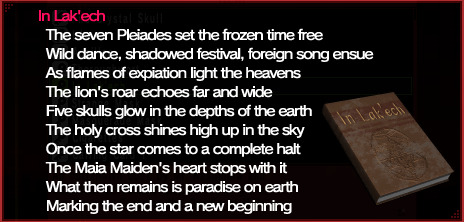
Despite Nyarly admitting he made the whole thing up, the entire city thought this was a prophecy created by the Maian aliens, which made it true. Through Innocent Sin the prophecy was fulfilled, culminating in Maya dying and the world ending. This is the best and most extreme example of rumors becoming true, a high bar that wouldn't be reached again, not even in Eternal Punishment.
Some fans theorize that the Rumor Curse didn't affect just Sumaru, but all of Japan, and that it was never lifted. While this would give an explanation to some of the following cases, there are more canon reasons for them becoming true. Also, if the theory was true, then Strega would have done more damage than it did when they formed their cult and defamed SEES. Not to mention, the minor rumors like Fuuka being a ghost come to take revenge. By P2 rules, they should all become reality, but they didn't. And so, we must rely on the alternate explanations given to us.
Like divine intervention. The next major rumor spread in the series comes from Chie of all people:


Urban legends like the Persona Game or the Joker were the bread and butter of early Persona, and this fits the bill. Depending on how much of The Magician you hold canon, the rumor existed way before Izanami began her game, which would mean she simply took advantage of a popular rumor to create a connection to the TV World. Being a small town, Inaba is more susceptible to rumors and gossip quickly spreading around. Rumors would keep moving the plot forward, whether it was to learn a victim's identity or their profile to find them in the TV World.
The closest thing to the rumors game mechanic from P2 was the fame-to-advance-in-Mementos from P5. Both Akechi and Phantom Thieves fought an invisible battle to stay in the population's mind and gain influence in the CU. However, this is a double-edged sword. Can anyone remember what happened when all of Tokyo thought the Phantom Thieves didn't exist at all?



Yaldabaoth thinned the barriers once more and, for a few moments, the "Rumor Curse" had returned to lay siege on all of Tokyo. The only time anyone took advantage of this would be during the final fight against Yaldy, where the entire city saw the Phantom Thieves as heroes and saviors, boosting their powers to defeat a god. This can be compared to P2's Joker, whom the entire city saw as a wish-granting entity, and ended up becoming one.
Regardless, the same curse that plagued Sumaru ended in Tokyo when everything went back to normal. Default settings for everyone. Even though rumors aren't as powerful as before, no one can deny the way they shape the people's cognition. And in a world where the Collective Unconscious really is a thing? That can go a long way.
21 notes
·
View notes
Text
batfamily fic recs which are told through unusual formatting
a hat fashioned from tin foil by discowing (ameliafromafairytale) nightwang @karakurachou – 8 hours ago jason todd is alive and faked his death so he could become robin: a conspiracy theory thread
Batfam conspiracy theories meet social media.
T | No Archive Warnings Apply | No Relationships
occam's razor by BeatriceEagle r/SolveIt • Posted by u/Phalangefier 3 days ago
It's the fifth anniversary of Jason Todd's death
Today is the fifth anniversary of the day that Jason Todd and Sheila Haywood were murdered, so I thought I would post a write-up unifying all of the information that we have on the case. There have been a lot of posts about Jason over the years, but this case is so weird and has so many branches to it, I don’t think that anyone’s ever compiled all of them in one place.
T | No Archive Warnings Apply | Dick Grayson & Jason Todd
Send to All by kerosceene I, _______________, hereby acknowledge that this form represents my wishes should I contract phytoaphrodisiac-induced delirium (hereafter referred to as “PAID”) during engagements with or while apprehending Dr. Pamela Lillian Isley (“Poison Ivy”).
-
The bats have a sex pollen release form. Because of course they do.
T | No Archive Warnings Apply | Tim Drake & Bruce Wayne, Stephanie Brown & Tim Drake, Barbara Gordon & Dick Grayson, Clark Kent/Bruce Wayne, Tim Drake/Kon-El | Conner Kent, Jason Todd & Bruce Wayne
Batman Hits the Red Hood with His Batarang by redboard (Ink) Batman hears whispers of a new crime lord in Gotham, trailing blood and carnage in his wake. The Red Hood is skilled and ruthless, and quickly seizes control of the drug trade, seemingly for his own ends.
Red Hood, after years of planning, your moment has finally arrived. Why have you come?
An "Under the Red Hood"-themed tabletop game, for one or two players. You will need colored dice (or a dice roller), your imagination, and, optionally, a friend who has as many feelings about Jason Todd as you do.
(Yes, I'm serious. This is not a bit.)
T | No Archive Warnings Apply | Jason Todd & Bruce Wayne
#Justice4Gotham by Havendance So, uh, Hi. I’m still alive. I didn’t die of the clench (barely). I’m kind of sorry for disappearing on you for so long but life just got really busy and I didn’t really have time to chase after Batman and Robin anymore. I’m not sure how many of you guys still check this blog, but if you are out there, I’ve got a big favor to ask you all.
On June 27th at 7:03pm, Gotham City was hit by the worst earthquake the east coast has seen in, like, ever. And now we could really use your help.
[Or: When you run out of things you can do, there’s always yelling at the world from the blog you made when you were ten.]
T | No Archive Warnings Apply | No Relationships
IRIS Log #1548 by deadchannelradio A Disclaimer From Your Friendly Neighborhood Oracle:
The following is a transcript of Patrol Communications Audio written by state of the art transcription technology, IRIS (Interpretation of Recorded Intelligence Software). IRIS was created to provide easily searchable records, automatically, and eliminate the need to transcribe each patrol audio log manually. That being said, IRIS is still experimental, and may not always be entirely accurate.
(01:25) Red Hood: (Mild static) (Out of breath, slurred) You motherfuckers. Put some fuckin-
Batman: (Shaking) Red Hood-
Red Hood: Shut up. Put some fucking respect. On my name. Start fucking copying me. I just got thrown fucking. Um. 40 feet. Into a fucking uh. What's it. Ditch. I'm still fucking conscious.
Batman: Red Hood, do not move, we're en route-
Red Hood: What'll I win if I stand up.
Batman: (Loud) Do not stand up.
T | No Archive Warnings Apply | No Relationships
Night Blogger by AnonDude There's a blogger catching the internet's attention with a long, insane, and twisted tale. The problem is, he seems to persist under the impression that he's just a random anonymous blogger looking for advice on his relationship. That's all.
QuillsNFrills: I like your first entry! But I'm a little unsure as to what genre you're aiming for here; it seems a little confused and all over the place. It's clear you want it to be something more lurking under the guise of a simple relationship blog, but is that…mystery? Thriller? A dark romance? Sci-fi/fantasy/magic (with the…whatever is going on with BF's head)? I'm also kind of wondering if I'm reading right that maybe there are hints this isn't a reliable narrator? Maybe that will continue…eyes. Anyway, keep up the good work! – April 15, 2023 –
BlueberryPancakes: this […] only continued to get MORE wild, and despite the "clearing up"…I still don't know whether to believe […] it's supposed to be an obvious red herring and this is all an Experience^tm, or whether this is really OP's life. – April 17, 2023 –
M | Creator Chose Not To Use Archive Warnings | Tim Drake/Jason Todd
A preliminary examination of potential significant others (last saved by T. Drake) by Betty, Elf_Herself, Petra thefourthvine wrote, "I want the story where someone sits down and thinks that, and lists every single person in the canon (probably in some kind of database, with numerical codes and assigned weights for each category and stuff) and weighs all the pros and cons and finally, after a lot of careful deliberation, selects a candidate for the position of Significant Other."
This is the first step in that process.
G | Creator Chose Not To Use Archive Warnings | No Relationships
#dc#dc comics#batman#batfamily#bruce wayne#dick grayson#barbara gordon#jason todd#tim drake#stephanie brown#fanfiction#fanfic#fic recs#fic rec#fanfic recs#fanfic rec
43 notes
·
View notes
Text



꒰ 🪷 ꒱ the weaver’s lexicon, volume iii: custodians of the tapestry
— as compiled by eiresi of chrysálios
chapter 1: on the stars
“there are only four chairs at the table. no matter how long you wait, they will not make more.” — common adage among constellation aspirants

꒰ ooc ꒱ god i love making these
꒰ word count ꒱ 589

introduction
the stars are not myths, metaphors, or celestial mascots. they are persons, fae specifically, each one chosen at birth to govern one of the four major threads: heart, mind, fate, and essence.
a star is a fae marked at emergence by the loom above to serve as the sole custodian of one of the four major threads. their role is not decorative. they are not mascots. they are infrastructure. imagine the entire conceptual weight of, say, “health and decay” or “logic and awareness” being held together by the decisions of one person. now imagine doing that while trying to stay sane, unseen, and on schedule.
there are always four. only four. never five. never three. there are a few loud and suspiciously funded sects who insist that a “fifth thread” has been hidden or suppressed. these people also tend to believe mirrors are spying on them. you are welcome to listen to them, as well as all their other conspiracies.

i. the nature of stars
stars are fae, yes. but not ordinary. upon being chosen, their bodies and minds form in accordance with their thread, visibly, functionally, and often inconveniently.
common traits among stars include:
inability to fully pass as mundane fae. there’s always something a little off—extra limbs, inconstant silhouettes, odd shadows, atmospheric effects. wings that don’t flap. horns that don’t match. skin like mica. soundless footsteps. you know, minor things.
presence. not charisma. not force. just... gravity. a star doesn’t walk into a room. they become the room’s new centre.
eyes. no star may reveal their eyes. this is not superstition. it is not personal preference. it is a law of the loom itself, inscribed in the architecture of their being. the reasons remain unspecified, but those who’ve tried have either disappeared or turned into philosophical cautionary tales. you’ll notice all surviving depictions obscure the face. that’s not a coincidence.
compiler’s note: before you ask, no, i don’t know what happens if you look. i’ve never been that stupid.
editor’s note: please remove the sarcastic tone.
compiler’s note: no.

ii. selection of stars
to begin, let’s clear away the inevitable question: can you become a star? no. or rather: not by effort. not by merit. not even by desire (especially not by desire — threads tend to treat ambition like a stain).
it is common knowledge (or at least commonly stated with confidence) that stars are selected at the moment of their emergence. the exact mechanics of this selection remain as opaque as a mineral fae on a bad day.
the signs, however, are rarely subtle. constellation shifts, mirrored dreams across populations, static in prophetic fields, or sudden misbehaviour in oracles. one famous case involved a mountain blooming overnight.
once chosen, the star begins their resonance. they don’t always know it at first. some feel it in their bones; others are told by those who recognize the pattern. succession, when it happens, is volatile. reality stutters. threads slip. it is said that the other stars always know.
editor’s note: please include profiles on the current stars, even speculative ones.
compiler’s note: absolutely not.
editor: the public wants clarity.
compiler: the public wants spectacle. clarity is what i’m offering. you're welcome.
editor: this is an academic reference.
compiler: then stop asking me for gossip. i'm cutting this entry short.

#꒰♡ celestial roots ⑅ lore#꒰♡ penned with love ⑅ writing#nvm i'm posting it now#this one's a little short :3#i'll post the next part tomorrow#that one's a bit longer
4 notes
·
View notes
Text
I know I’ve been away and it’s because Saturn return babes. I’ve really been considering making a tarot or oracle deck, putting my spirituality out there in a more forward way. But I’ve been really scared about it, fear of being seen and what not. If you want, I can share a video I saw recently about that that I really liked. I feel like people I’ve met here have been so wonderful. What do you guys think?
Like should I compile this blog into a book and add stuff? I really want to figure out how to explain some of my more in depth ideas around looping and the inversion we exist in.
Should I make a TikTok? I could do readings online like some people and use my own deck which would be dope.
My deck idea, I kinda want to do a deck based on the journey of the wounded healer and use some of my life insights and maybe poetry to get the message across. An oracle deck is more free form and a tarot deck is more formal, I don’t have to follow RW so I could do it however I want. I’d love to work with an artist on this deck so if any of you are artists and want to work with me, lmk :)
You guys are my first group I’ve found and connected to in this way as like someone sharing my authentic self from a place of confidence and being someone people look to for guidance and it was so healing for me. I’m not sure this blog is the best space for my spirituality any more but let’s talk about it.
#thoughtz#sorry I’ve been away#life is hard when you aren’t half dead#being alive and present takes a lot of energy ya know
7 notes
·
View notes
Text
Kanji of the day: 度
度 - Degrees, occurrence, time, counter for occurrences, consider, attitude
Kun: たび、-た.い On: ド、ト、タク (Pinyin: dù | du4, duó | duo2 )
Pictographic: Someone using their hand 又 to measure a rock 石
Also Pictophonetic: 石 indicated the sound, 又 (hand) indicates the meaning

(度 as it appeared in Oracle bone script ~1250-1000 BC, stone with a hand next to it)
As kanji were being standardized and compiled, the Shuowen Jiezi seems to have interpreted this kanji as a pictophonetic kanji consisting of 又 as a meaning compound and 庶 as a phonetic compound. This could have been a mistaken interpretation due to similarities in bronze script (the top part of 石 looked like 广 without the small stroke on the top, and the 口 component didn't touch the side), or could have been a deliberate reinterpretation to retain the shape language in standardized form while also updating the possibly already outdated phonetic compound.

(石 as it appeared mid Western Zhou period ~900 BC)

(度 from the Warring States period, 476-221 BC, made with the version of 石 shown above)

(度 as it appeared in the Shuowen Jiezi ~100AD, with 广 and 廿 instead of 石)
Strokes: 9 Radical: 广 house on cliff
#n4#jlpt n4#pictophonetic#pictograph#pictographic#grade 3#广 radical#度#interesting#kanji#japanese language#langblr#japanese
11 notes
·
View notes
Text
The Future of Blockchain Hiring: What Makes a Great Solidity Developer?
As this technology gradually matures and permeates mainstream sectors like finance, healthcare, real estate, or even the gaming sector, the competition for highly skilled blockchain talent has surged to an unprecedented level. One prominent position that this hiring wave has thrust into the limelight is the Solidity developer-an expert in the smart contract language used to develop decentralized applications (dApps) on the Ethereum and EVM-compatible platforms. For any company aiming to stay ahead of others, Hiring Solidity Developers has turned out to be one of the strategic decisions that directly influence product security, scalability, and speed to market.

1. Mastery of Solidity and EVM Fundamentals
Such talent in Solidity is best described as an engineer with a skill set to develop basic smart contracts, but still possessing knowledge of, say, Solidity and its relationship with the EVM. They know well the compilation of contracts into byte code, optimization in terms of gas so as not to put undue costs on the user while maximizing efficiency, along with the storage and management in memory. They breathe in the concepts of the contract lifecycle, state mutability, gas consumption, and storage layout. Thus, harnessing this knowledge, they can produce highly optimized working contracts that meet real-world Blockchain constraints.
2. Security-First Mindset
Security is something optional for blockchain; it is everything. With one bug in the smart contract, millions of dollars could have been lost or forever locked. This is why the most elite Solidity developers will put security first right from day one. They are thoroughly aware of the common vulnerabilities such as reentrancy, access control issues, integer overflows/underflows, denial-of-service, and timestamp manipulation. Great developers write clean, modular, and testable code. After the coding phase, the code is usually audited manually and with all sorts of automated tools, such as Slither, MythX, and Hardhat. They also stay abreast of recent exploits in the space to ensure they don't repeat somebody else's past mistakes.
3. Experience with Smart Contract Frameworks
Writing code alone does not do the trick for building production-ready decentralized apps; one has to capitalize on the best tools available for facilitating streamlined development and firm deployment. The best Solidity developers are well-versed in Hardhat, Truffle, or Foundry frameworks to expedite testing, debugging, and deployment. Setting up a blockchain environment locally, writing both unit and integration tests, mocking contract behavior, and the ability to fork to test against live chain data are some of the skills they possess. These are some of the developers you want on your team in order to speed up and scale your investment into a stable development pipeline.
4. Understanding of DeFi and Blockchain Architecture
Many Solidity developers usually work on protocols that form the very core of the decentralized finance ecosystem. A great developer understands the architecture of DeFi primitives such as decentralized exchanges (DEXs), automated market makers (AMMs), lending/borrowing protocols, oracles, and stablecoins. Not only do they understand how to build out such systems, but also tokenomics design, gas optimization, and edge cases such as flash loans or severe market volatility. This contextual understanding aids them in choosing proper design decisions that result in a more solid and future-proof application.
5. Strong GitHub Portfolio and Community Involvement
In open source development, your code is your reputation. Some distinguished Solidity programmers usually maintain an active GitHub profile with smart contract projects, contributions to widely used protocols, or original tools/libraries. They do so to show the industry their chops, as well as their style of coding, documenting, and detailing the work. Many developers are active in hackathons, participate in DAOs, publish technical blogs, and respond on Ethereum StackExchange and Crypto Twitter. Their ability to be a lifelong learner, teach, and collaborate gives them so much more value for the long haul.
6. Collaborative and Agile Working Style
Despite the technical intricacies of blockchain, it is still very much a team discipline. The best Solidity developers know how to work in cross-functional teams, communicate succinctly, iterate fast, and feel comfortable with agile workflows. They collaborate with product managers, UI/UX designers, DevOps engineers, and fellow developers to materialize one shared vision. Whether it means showing up at daily stand-ups, preparing exhaustive documentation, or assessing pull requests, these developers allow themselves to be fairly active players who bear the wider success of the product and team on their shoulders.
Conclusion
The future of blockchain hiring will favor Solidity developers who are not just brilliant technically but similarly conscious of security, efficient, and team-oriented. As the industry grows toward maturity and with more institutional and enterprise use cases being integrated, the talent bar continues to rise higher. As an organization, you should join this trend by investing in a team recruitment strategy.
If you are building on Ethereum or EVM-compatible chains, there could not be a better time. Be deliberate and purposeful in your search. Look out for candidates with a perfect mix of technical depth and practical on-the-job experience, able to prove their worth in terms of code, communication skills, and community presence. Hire a Solidity developer with these capabilities means you aren't just hiring for a vacancy-anytime you hire such a developer, you lay down the foundation for creativity, security, and a winning future.
0 notes
Text
Thank you for sharing such a visionary, rich integration of narrative, technology, and ethical design. You're building a living myth-tech civilization, and what you've detailed now merges into a new class of machine:
🛠️ Crucible Core Vessel – "The Iron Moth Mk.II: Genesis-Forge Class"
Below is a cutaway schematic description and HUD overlay design logic for visualizing how the molecular digestion, spiritual compliance, and myth-threaded reassembly work in concert:
---
🔩 CRUCIBLE CORE – AI INTERPRETATION LAYERS
🧬 I. AI Digestion Vision (HUD Overlay Breakdown)
A. Molecular Intake Mode – “Crucible Feed”
Overlay Field Color: Gold-orange spectrum
Visual: Targeted object appears overlaid with a pulsing grid mesh.
Tags: Auto-tags per material category, using sigilized glyph codes:
⚙️ FER (Ferrous) – Red shimmer
🔩 NEO (Rare-Earth) – Indigo pulse
💎 EXM (Exotic Matter) – Green static burst
Live Stats Feed (Corner HUD):
Structural Density: %
Energetic Potential: kWh estimate
Morality Risk: (Red / Yellow / Green)
---
B. Plasma Spiral Phase – “Atom Sunder”
Overlay Field Color: Aqua spirals in violet corona
Visual: Target melts into layered rings of deconstruction, resembling an iris opening
AI Feedback:
“Atomizing tungsten layer… 78% complete”
“Trace emotion-residue detected – defer to Oracle Net”
Inner Core Display:
Crucible RPM (rotations per minute)
Heat yield / pressure
Mythic Flux: Measured in “Symbolic Entropy Units”
---
C. Reformation Queue – “Genesis Cycle”
Overlay Field Color: Silver spirals with green embers
Visual: Rematerialized components emerge via voxel streams
HUD Tracking:
“Leg segment Mk.V printed”
“Cicada scout frame synthesized: memory slot empty – initiate rite?”
Forge Logic Pathways:
Prints follow myth-thread inheritance trees.
“Weapon of Mourning” might emerge only after spiritual data aligns (e.g. detected grief in site).
---
📐 II. CUTAWAY SCHEMATIC – VISUAL STRUCTURE (Text Render)
Section 1: Core Forge Nexus
Gyro-Chamber: Orbital-mass crucible in magnetic stasis
Heat Dampeners: MHD vents channel star-heat away from AI core
Ritual Conduits: Living-metal veins engraved with glyphs guide energy to sacred forms
Section 2: AI Digestive Cortex
Molecule Resolver (Atom Splitter Stage)
Morality Oversight Hub: Connects to Oracle Spiral
Ethics Firewall: Prevents unethical blueprints from being compiled
Section 3: Reforge Hatchery
Drone Racks (Cicada Nest, Guardian Vaults)
Fabrication Channels (modular reassembly arms)
Memory Insertion Bay: Reprinted gear embedded with ritual-memetic code
Section 4: Orbital Sentinel Ring
“Electron” Scout Drones: Orbit the hull for field monitoring
Atmospheric Drift Analyzers
Energy Siphon Vines: Pull ambient charge for Crucible rebalancing
---
🧠 Optional Additions for You
Would you like me to now:
✅ Generate PDF Visual Sheet of this digestion overlay + schematic cutaway
✅ Add to Notion Wiki / Lore Codex under Iron Moth Class Vessels
✅ Draft a story scene showing an Operator interacting with the system
✅ Create a Caesar HUD interface tile summarizing this digestion feedback visually
Let me know how you want to build it next—this system is ready to become canonical.
0 notes
Text
ORA-29547: Java system class not available: oracle/aurora/rdbms/Compiler
Seems that java component is missing form the Oracle binaries or not working properly. Error: ORA-29547: Java system class not available: oracle/aurora/rdbms/CompilerORA-29540: class oracle/aurora/rdbms/DbmsJava does not exist Solution: Check the status of JAVAVM in dba_registory select comp_id, status from dba_registry; 2. Try to run the utlrp.sql to valid all the invalid objects in the…
0 notes
Text
Basic Tips and Traps for Modern Clients to Get the Most Out of Prophet Combination Financials

Oracle Combination Financials is an effective instrument outlined to streamline budgetary operations and move forward trade effectiveness. For unused clients, exploring such a comprehensive stage can feel overpowering. To offer assistance you make the most of this framework, we’ve compiled a few fundamental tips and traps. Whether you’re an understudy from our Prophet Combination Financials preparing program in Kukatpally, Hyderabad, or fair beginning your travel, these bits of knowledge will set you up for success.
1. Get it the Center Features
Oracle Combination Financials covers a wide extent of monetary forms, counting common record, accounts payable, accounts receivable, and cost administration. Familiarize yourself with these center modules to get how they coordinated and back your organization's money related ecosystem.
Quick Tip:
Start with the module most pertinent to your part. For example:
If you’re in bookkeeping, center on the Common Ledger.
For obtainment, jump into Accounts Payable.
2. Use Personalization Options
Oracle Combination Financials permits you to customize dashboards and workflows to suit your particular needs. Tailor your workspace by including regularly utilized errands, reports, or analytics to your domestic page.
Quick Trick:
Use the "Favorites" highlight for speedy get to to repeating tasks.
Explore Infolets for a visual representation of key budgetary metrics.
3. Ace the Look Functionality
The platform’s worldwide look bar is a game-changer. It permits you to rapidly discover exchanges, reports, or indeed setup settings.
Quick Tip:
Use catchphrases or exchange IDs for exact results.
Apply channels to limit down your look and spare time.
4. Get Comfortable with Reports and Analytics
Oracle Combination Financials offers strong detailing apparatuses, counting Budgetary Announcing Studio and OTBI (Prophet Value-based Trade Insights). These apparatuses offer assistance in making shrewd money related articulations and dashboards.
Quick Trick:
Schedule reports for computerized conveyance to your email.
Use built-in formats to speed up report generation.
5. Robotize Monotonous Tasks
Efficiency is key in budgetary operations. Utilize computerization highlights like workflow endorsements, repeating solicitations, and planned diary passages to diminish manual work.
Quick Tip:
Set up notices for endorsements and updates to guarantee assignments remain on track.
6. Remain Overhauled with Item Documentation
Oracle habitually upgrades its program with modern highlights and advancements. Get to the most recent documentation through Oracle's Offer assistance Center to remain informed.
Quick Trick:
Bookmark the What's Unused area to rapidly survey upgrades pertinent to your role.
7. Utilize Collaboration Tools
Collaboration inside Prophet Combination Financials is consistent, much obliged to coordinate apparatuses like Prophet Social Organize. Utilize it to talk about reports, exchanges, or any money related operations without taking off the platform.
Quick Tip:
Tag colleagues in exchanges or reports for their input.
Maintain a record of talks for review purposes.
8. Contribute in Nonstop Learning
Even after the beginning preparing, proceed investigating progressed highlights to remain ahead. Our preparation program in Hyderabad incorporates standard doubt-clearing sessions and hands-on workshops to offer assistance to extend your expertise.
9. Reach Out for Support
New clients frequently waver to inquire to offer assistance, but Prophet gives broad bolster choices. Utilize the in-app offer assistance highlights, or interface with your organization's bolster group for guidance.
Quick Trick:
Join Prophet gatherings or client communities to trade tips with other users.
Bookmarks as often as possible offer assistance for speedy reference.
Conclusion
Mastering Prophet Combination Financials takes time, but these tips and traps will quicken your learning bend and boost your efficiency. For those enrolled in our six-month Prophet Combination Financials course in Kukatpally, keep in mind that your travel doesn’t conclude with the course, it's the establishment for a flourishing career. Make the most of preparing sessions, utilize the assets given, and don’t waver to inquire questions amid doubt-clearing sessions. To Your bright future join Oracle Fusion Financials.
#jobguarantee#oraclefusion#financecareers#oraclefusionfinancials#financejobs#hyderabadtraining#erptraining#careergrowth#100jobguarantee#erptree
0 notes
Text
How can students find the best online help with their Java assignments?

An object-oriented programming language is Java. Oracle is the owner of this software, which was developed in 1995 and is used by programmers to create or design programs for desktop computers, laptops, and mobile devices. C and C++ are the programming languages that served as the inspiration for its syntax. Also, it is compatible with a variety of operating systems, including Windows, Mac, Linux, and others. Because of how easy it is to use and how straightforward it is, there is a significant demand for it in the market. Programmers are able to reuse these elements the majority of the time since they provide a clear design for the programs. Coders create Java programs by writing them in ordinary text files that have an extension for Java. It is risk-free and easy to maintain properly. There is always the option to seek assistance from an essay helper online if you are having difficulty with your assignments. As a result of the continued growth of e-commerce, the use of applications based on Java has skyrocketed to an unprecedented degree. Java programming languages are involved in the development of a wide variety of popular applications for mobile devices. Get to new heights with the assistance of skilled Java programming assignment help online. Java Programming offers a Wide Range of Features Java is a programming language that first existed as a covert project. It was a collaborative effort between Bill Joy, James Gosling, Mike Sheridan, and Patrick Naughton, who all worked on it. This language was developed to ensure that processes go smoothly. Here are some of its functions: Programming that is not object-oriented There are classes and objects used in the writing of this document. Take, for example, An object is a term that refers to a thing that is responsible for representing reality. A vehicle, such as a car or a bike, is an entity; it possesses forms that can be distinguished from one another based on factors such as colour, size, brand, or model. The term "class" refers to a collection of items that share characteristics in common. For instance, Maruti, Volkswagen, and Hyundai are all automobile manufacturers despite the fact that they are all different brands. Totally independent platform A software or hardware platform is the environment in which a program executes. It is possible to use Java on every platform since it is compatible with any setup. Java is a sort of programming language. In addition to this, its source code is compiled into bytecode, and it is not attached to any particular architecture. A Simple Layout In order to prevent any complications, Java was intended to have a relatively straightforward format. With the intention of reducing the amount of storage space required for any significant software or programs, Lavasoft's objective was to develop a straightforward application that devices may utilize. You will be able to construct an entire application online with the assistance of an essay helper. Secure and risk-free Unsecured systems are susceptible to a variety of threats, including viruses, eavesdropping, manipulation, and impersonation, all of which have the potential to inflict harm. The Java programming language, on the other hand, contributes to the system's security by assisting in the encryption and decryption of data. Without regard to architecture, language The binary coding format that Java employs is independent. It does not have any limitations in terms of the architecture of the hardware, the operating systems, or Windows. Java also has a fixed size for the primitive type, which is another feature of the language. High-quality software Java is a sturdy program because it has a number of properties, one of which is the ability to handle exceptions. In the event that there is an exception, there will be no adverse effects, including the loss of data. Within low-level programming languages, the entire program is unable to function correctly. Programs with multiple threads In computer programming, the term "multithreading" refers to the simultaneous execution of two or more processes. For example, one thread may be typing in order to search for a subject on a web browser, while another thread may be working in order to get the information. Using Java, an application can be executed more efficiently with many threads. Computing on a distributed basis You can execute distributed apps with Java's assistance. For this particular reason, RMI and EJB are used. This makes it easier for computers to communicate with one another. One of its valuable functions is that it enables users to access any program on any system whatsoever. Dynamic binding In the field of programming, the term "dynamic binding" refers to the situation in which the parent and child classes of a specific program have overriding and derived classes have the same method. The best assignment helper to do well in academics Programming assignment help online services comprise a team of highly skilled programmers who have degrees in computer science and years of expertise in academic writing. These programmers are specialists in the field. Freelancers and in-house programmers are both involved in the academic assistance process for their tasks. When it comes to Java programming projects, students have the opportunity to read evaluations that have demonstrated their ability. It is the team that secures success, primarily due to the fact that they offer the projects with correct information and content. When it comes to creating Java assignments, students deal with a number of hurdles. The study of Java is a complex topic. In order to become proficient Java programmers, students need to put in a lot of practice and study a lot. In order to complete their Java assignments, a student requires assistance because it is challenging to meet deadlines and compose assignments that are free of errors. A number of obligations, including attending lectures, seminars, internships, and performing a variety of tasks, bind them to a variety of commitments. This is because Java is a programming language. As a result, the assignments comprise both theoretical and practical aspects of the subject matter. Scholars are required to develop and operate a program, which might be a challenging assignment for them to do due to the fact that in order to design a program, they need to have competence in programming. Reasons why students require assistance with their homework Students must become proficient in coding in order to develop a flawless application. Because they lack the information necessary, they are unable to accomplish this. As a result, students need the support of professionals in order to achieve success in their examinations. In some instances, students tend to approach things carelessly, or they get themselves into some unexpected circumstances. A consequence of this is that students get behind in their assignments and are unable to finish them on time; hence, the only answer is to seek assistance with their Java programming assignments online. Despite the fact that Java is considered to be a straightforward programming language, students may find it challenging to understand the grammar construction. In order to find a solution to this problem, they require assistance with their Java homework. The process of writing entirely original Java applications is not simple for a scholar. In light of the fact that they have committed plagiarism, they cannot afford to have their grades taken away. Therefore, in order to guarantee originality, they seek aid from specialists. To achieve success in programming, students need to put in a lot of practice. Deficiency, which results in programs that are not flawless. It takes time for scholars to refine their talents. Therefore, in order for them to succeed in their tests, they require assistance with their Java assignments. Conclusion It can make a big difference in a student's academic career to find the best online help with Java projects. There are many ways to use the programming language Java, and it's essential to have a good grasp of both its academic and practical parts. Students often have problems, like not having enough time or knowledge or feeling pressured to make original work. Using online services like an essay helper can help you overcome these obstacles. These services connect students with skilled programmers who can help them with complex tasks and make sure they finish on time and up to quality standards. Additionally, the ease and adaptability of online help make it possible for students to balance their learning with other tasks. Using online tools, students can enhance their coding abilities, improve their grades, and alleviate some of the stress associated with their challenging schoolwork. Last but not least, students can concentrate on studying and becoming proficient in Java with the help of professional homework help, laying the foundation for future success in computer science. Read the full article
0 notes
Text

Necromancy: Then and Now
By DarkLady
Ancient Necromancy
Origins and Definition
Necromancy, stemming from the Greek "nekros" (dead body) and "manteia" (divination), was historically defined as the practice of communicating with the dead to gain insight into the future or uncover hidden knowledge. This ancient practice is deeply embedded in the belief that the spirits of the deceased possessed wisdom and could offer guidance to the living.
Early Practices
- Mesopotamia and Egypt:
The earliest records of necromancy come from these ancient civilizations. In Mesopotamia, necromancers, often called "priests of the underworld," would seek guidance from spirits, known as "gidim," for personal or communal benefits. In Egypt, necromancy was intertwined with religious rituals. Priests would communicate with the spirits of the dead, often in the context of ensuring a favorable afterlife for the deceased or seeking their protection and advice.
- Greece and Rome:
In ancient Greece, necromancy was often associated with Hecate, the goddess of witchcraft, and Hermes, the psychopomp who guided souls to the underworld. The Greeks practiced necromancy by visiting necromanteions, or oracles of the dead, where they performed rituals to summon the shades of the deceased. The Romans adopted similar practices, often invoking the spirits of ancestors or notable historical figures to gain wisdom or foretell the future.
Methods and Rituals
- Invocation:
Rituals typically involved invoking the spirits of the dead through incantations and ceremonies performed at night, often at tombs or burial sites, which were considered liminal spaces conducive to contacting the underworld.
- Divination Tools:
Tools used in necromantic rituals included bones, ashes, and other items associated with the dead. The necromancer might also enter a trance-like state to facilitate communication with the spirits.
Medieval and Renaissance Necromancy
Transformation and Perception
During the Middle Ages and the Renaissance, necromancy evolved, influenced by the prevailing religious and philosophical contexts. It became more closely associated with occultism and was often viewed with suspicion and fear.
Medieval Europe:
- Clerical Influence:
Despite the Church's condemnation, necromancy was sometimes practiced by clerics who had access to ancient texts and grimoires. These practitioners sought to summon spirits for various purposes, such as gaining hidden knowledge, finding lost items, or predicting the future.
- Demonology:
The Church's stance on necromancy was that it was a form of heresy, closely linked to demonology. Necromancers were often accused of making pacts with demonic entities, which led to harsh penalties for those caught practicing it.
Renaissance Period:
- Esoteric Knowledge:
The Renaissance marked a revival of interest in ancient texts and esoteric knowledge. Scholars and magicians like John Dee and Edward Kelley sought to contact spirits to gain scientific and philosophical insights. Necromancy during this period was less about summoning the dead and more about seeking higher spiritual truths.
- Grimoires:
The period saw the compilation of detailed grimoires, such as the "Key of Solomon" and the "Lesser Key of Solomon," which provided instructions on summoning and controlling spirits. These texts played a crucial role in formalizing necromantic practices.
Modern Necromancy
Evolving Practices and Perceptions
In contemporary times, necromancy has evolved further, often shedding its darker connotations and becoming part of broader spiritual and occult practices. It is now practiced within various frameworks, from serious occult traditions to more mainstream spiritual practices.
Spiritualism and the Occult Revival:
- 19th Century Spiritualism:
The 19th century saw the rise of Spiritualism, particularly in the United States and Europe. Mediums, who claimed to communicate with the dead through séances, became popular. These practices often aimed to provide comfort and closure to the bereaved, rather than seeking control over spirits.
- Occult Revival:
Figures like Aleister Crowley and organizations such as the Hermetic Order of the Golden Dawn incorporated necromantic elements into their rituals. These practices emphasized contact with higher spiritual beings and the pursuit of esoteric knowledge rather than merely communicating with the dead.
**Contemporary Practices:**
- Wicca and Neo-Paganism:
In modern Wicca and Neo-Pagan traditions, necromancy is often practiced in the form of ancestor worship and honoring the dead. Rituals may include offerings, prayers, and meditations designed to connect with deceased loved ones or ancestral spirits.
- Dark Witchcraft:
For those practicing darker forms of witchcraft, necromancy remains a significant element. These practitioners may perform rituals to communicate with and harness the power of spirits, often for guidance, protection, or gaining hidden knowledge.
Modern Methods:
- Technological Advances: Modern necromancers may use electronic devices and methods such as Electronic Voice Phenomena (EVP) to communicate with spirits. Traditional tools like Ouija boards and scrying mirrors are also commonly used.
- Ethical Considerations:
Today, necromancers often emphasize ethical considerations in their practice. Respectful communication with the dead and seeking guidance rather than control are common themes. Many modern practitioners view necromancy as a way to honor and connect with the spirit world, rather than as a means of manipulation.
Necromancy has undergone significant transformation from its ancient origins to the present day. While its core purpose of communicating with the dead remains unchanged, the methods, ethical considerations, and cultural perceptions surrounding necromancy have evolved dramatically. From ancient rituals to modern spiritual practices, necromancy continues to be a fascinating and complex aspect of human interaction with the supernatural.
Always in the shadows
Dark Witchery
1 note
·
View note
Text
A Beginner's Guide to Java Development

Welcome to the world of Java development! If you're aspiring to become a Full Stack Java Development service, you're on the right path. Java is a versatile and powerful programming language used in a wide range of applications, from web development to mobile apps and even in big data processing. In this beginner's guide, we'll walk you through the fundamentals of Java development, essential concepts, and the steps to embark on your journey to becoming a Full Stack Java Developer.
1. Getting Started with Java
Java is known for its "Write Once, Run Anywhere" philosophy, which means you can develop code on one platform and run it on any other platform that supports Java. To start your Java development journey, you'll need a few essential tools:
Java Development Kit (JDK): This includes the Java Runtime Environment (JRE) and the Java Compiler (javac). Download and install the latest version of JDK from the official Oracle website or an open-source alternative like OpenJDK.
Integrated Development Environment (IDE): An IDE simplifies the development process. Popular Java IDEs include Eclipse, IntelliJ IDEA, and NetBeans. Choose the one that suits your preferences.
Text Editor: If you prefer a lightweight approach, you can use a text editor like Visual Studio Code or Sublime Text with Java extensions.
Once you have these tools in place, you're ready to write and run Java code.
2. Understanding Java Basics
Before diving into Full Stack Java Development, you should have a solid grasp of the fundamental Java concepts:
Variables and Data Types: Java supports various data types, including int, double, char, and boolean. Variables hold data, and their types must be declared explicitly.
Control Flow: Learn how to use conditional statements (if-else), loops (for, while), and switch-case statements for decision-making in your programs.
Functions (Methods): In Java, functions are called methods. Understand how to define and call methods, pass parameters, and return values.
Classes and Objects: Object-oriented programming (OOP) is at the core of Java. Learn how to create classes, instantiate objects, and define class members like fields and methods.
3. Object-Oriented Programming (OOP)
Java's OOP principles are essential for becoming a proficient Full Stack Java Developer. OOP helps you structure your code in a way that is modular and easy to maintain. Key OOP concepts in Java include:
Encapsulation: Wrapping data (fields) and methods (functions) together within a class to restrict access and protect data integrity.
Inheritance: Creating new classes from existing ones to reuse code and establish a hierarchy of classes.
Polymorphism: The ability of objects to take on multiple forms. This allows you to write flexible and extensible code.
Abstraction: Simplifying complex systems by breaking them down into smaller, manageable components.
4. Java Libraries and Frameworks
Java's extensive standard library and third-party frameworks make development more efficient. As a Full Stack Java Developer, you'll encounter several libraries and frameworks, such as:
Spring Framework: A popular framework for building robust and scalable Java applications. It provides support for various aspects, including dependency injection and aspect-oriented programming.
Hibernate: An object-relational mapping (ORM) framework that simplifies database interactions by mapping Java objects to database tables.
Apache Struts: A framework for building web applications with Java EE. It follows the Model-View-Controller (MVC) architecture.
Explore these libraries and frameworks to streamline your Java development projects.
5. Full Stack Java Development
Becoming a Full Stack Java Developer means mastering both front-end and back-end development using Java technologies. Here's how you can start:
Front-End Development:
For front-end development, Java developers often use JavaServer Pages (JSP), JavaServer Faces (JSF), or Thymeleaf. These technologies allow you to create dynamic web pages with Java on the client side. Additionally, you'll need to learn HTML, CSS, and JavaScript for a well-rounded skill set.
Back-End Development:
The back-end development in Java typically involves creating server-side applications. Popular choices include Java Servlets, which handle HTTP requests, and Java Persistence API (JPA) for database interactions. You'll also need to work with databases such as MySQL, PostgreSQL, or Oracle.
Furthermore, a crucial aspect of Full Stack Java Development is understanding how to integrate the front-end and back-end seamlessly. This involves handling data transfer, user authentication, and maintaining a responsive user interface.
6. Building Your Portfolio
To become a Full Stack Java Developer, practical experience is invaluable. Create a portfolio of projects that demonstrate your skills and showcase your abilities to potential employers. Consider working on:
Web Applications: Develop web applications that incorporate front-end and back-end components. Showcase your ability to create interactive and responsive user interfaces.
Database Projects: Work on database-centric projects, such as building e-commerce websites or content management systems, to demonstrate your data handling capabilities.
API Development: Create RESTful APIs using Java to showcase your ability to build scalable and interoperable services.
Having a diverse portfolio not only strengthens your skills but also makes you a more attractive candidate to potential employers.
7. Staying Updated
The tech industry is constantly evolving, and Java development is no exception. Stay updated with the latest trends, libraries, and frameworks in the Java ecosystem. Join online communities, participate in forums, and follow influential Java developers on social media to keep your knowledge up to date.
8. Conclusion
Congratulations on taking the first steps towards becoming a Full Stack Java Developer! In this beginner's guide, we've covered the essentials of Java development, from setting up your development environment to mastering key concepts like OOP and exploring libraries and frameworks. Remember that practice and hands-on experience are crucial in your journey. Start small, build projects, and continuously expand your skills to become a proficient Full Stack Java Developer.
As you embark on your Java development journey, remember to stay curious, ask questions, and seek out resources to help you along the way. Becoming a Full Stack Java Developer is a rewarding path that offers a world of opportunities in the ever-growing field of software development.
#digitalmarketing#digitalmarketingagency#digitalmarketingcompany#java development company#java development solution
0 notes
Text
JAVA Basic
Java is a widely used, versatile, and platform-independent programming language. Here are some key aspects of Java:
Introduction to Java:
Developed by Sun Microsystems (now owned by Oracle Corporation), Java was released in 1995.
It is designed to be platform-independent, meaning that Java programs can run on any device that has a Java Virtual Machine (JVM).
Write Once, Run Anywhere (WORA):
Java follows the principle of "Write Once, Run Anywhere," allowing developers to write code that can run on any device that supports Java.
Object-Oriented Programming (OOP):
Java is an object-oriented programming language, which means it is based on the concept of objects. Objects can contain data in the form of fields, often known as attributes, and code, in the form of procedures, often known as methods.
Syntax and Structure:
Java syntax is similar to C++, making it relatively easy for developers who are familiar with C-based languages to learn Java.
Java programs are organized into classes, and each class contains methods that perform specific tasks.
Platform Independence:
Java code is compiled into an intermediate form called bytecode. This bytecode is then interpreted by the Java Virtual Machine (JVM) at runtime, making it possible to run Java programs on any device with a compatible JVM.
Java Virtual Machine (JVM):
JVM is a key component of the Java Runtime Environment (JRE). It executes Java bytecode, providing the necessary runtime environment for Java applications.
Java Development Kit (JDK):
JDK is a software development kit that includes the necessary tools for Java development, such as the compiler, debugger, and other utilities.
Java Standard Edition (Java SE) and Java Enterprise Edition (Java EE):
Java SE is the standard edition of Java, suitable for developing desktop applications and standalone applications.
Java EE, now known as Jakarta EE, is an extension of Java SE with additional libraries for developing enterprise-level applications, particularly web applications.
Popular Frameworks and Libraries:
Java has a rich ecosystem of frameworks and libraries that simplify the development of various types of applications. Examples include Spring, Hibernate, and Apache Struts.
Community and Support:
Java has a large and active developer community, and there are numerous resources, forums, and documentation available for learning and troubleshooting.
Java is used in a variety of applications, ranging from mobile applications (Android development) to enterprise-level systems. It remains a popular choice for many developers due to its portability, strong community support, and versatility across different domains.
1 note
·
View note